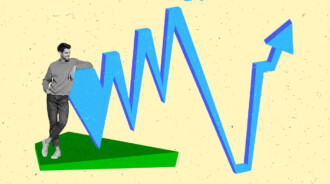

For beginners, trading can be a rollercoaster ride of highs and lows. Understanding the concept of higher highs and lower lows is crucial for making informed decisions and developing a working trading strategy. In this article, you will explore these concepts, including what they are, and how to identify and use them in your trading journey. Let’s dive right in.
What are the highs and lows in trading?
Highs and lows refer to the highest and lowest price at which an asset, such as security, has been traded. They are to show the price movement of a security within a specific period.
These prices are usually expressed in a time-based format, such as a 20-day high/low or 52-week high/low. For example, a 20-day high/low would indicate the highest and lowest price a security has reached in the last 20 days, while a 52-week high/low would indicate its peaks and troughs over the previous year.
One essential concept you should note is that these highs and lows are based on the closing price at the end of each trading day, meaning that even if the value of security breaches the high or low mark during the day, it will only be recorded if the asset closes at that price.
While this concept is relatively straightforward, it can become more complex when traders analyze patterns formed by the highs and lows to determine when to implement various strategies. As an aspiring trader, you must study the variations of these patterns to learn how to make more accurate forecasts.
What are higher highs and lower lows?
These terms refer to the price movements of a particular asset over a certain period. Using them in combination can be the basis of a robust strategy as these values can help you determine trends in the market and get into the banner of pro traders.
To identify upward trends in asset value, you have to use a simple technique involving higher highs and higher lows.
Higher High
A higher-high occurs when the security price closes at a higher price than the previous day’s close, which was also high. This is a reasonable indication of a rising trend that gives a trader confidence that the asset’s value is likely to continue rising in the near future.
Higher Low
A higher low is when the security price closes at a low cost, but that low is higher than the low at the previous day’s close. This also indicates a rising trend; traders can rely on their forecast that the asset’s value will continue rising shortly.
To identify downward trends in asset value, you can exploit a similar technique involving lower lows and lower highs.
Lower Low
A lower low occurs when the security price closes at a lower price than it did at the previous day’s close, which was also low. This is a reasonable indication that a trend is dipping, and a trader can easily forecast that the asset’s value will likely continue to descend in the near future.
Lower High
A lower high is when the price closes at a high one, but that high is lower than the high at the previous day’s close. This is also an indication that a trend is dipping and gives a trader confidence that the asset’s value is likely to continue descending in the near future.
To summarize the above concepts, a higher high plus a higher low indicates the expected and continued rise in the asset’s value. In contrast, a lower low plus a lower high is an indicator of just the opposite and allows investors and traders to temper their expectations when it comes to the performance of the asset in question.
You can develop specific strategies based on this knowledge, such as buying or selling a particular asset or security.
What is a Higher High/Lower Low trading strategy?
A Higher High/Lower Low is a popular trading strategy based on identifying trends in a stock’s price movements. It involves looking for higher highs and lower lows to determine the overall direction of the stock.
If the security reaches higher highs and higher lows, this is considered an uptrend, and the trader may look to buy it. If the stock arrives at lower lows and lower highs, this is regarded as a downtrend, and the trader may look to sell the asset.
This strategy is based on the idea that stocks follow a trend, and by identifying it, traders can make more informed decisions about when to buy and sell and benefit from it.

How to identify higher lows/lower highs pattern
Identifying patterns in the market, such as higher lows and lower highs, can be a valuable strategy for experienced traders. These patterns, which occur during downtrends, can provide opportunities to capitalize on changes in the market.
One way to exploit the patterns is through spread trading tactics in an inverted way for a more standard lower high/lower low model. However, it is essential to note that there is no one correct way to tackle the market, and different professional investors, analysts, and brokers have their own unique strategies. These techniques, known as countertrend ones, are specifically designed to take advantage of higher high/lower low or lower high/higher low patterns.
Higher High/Lower Low patterns in countertrend strategies
When an investor or trader employs a countertrend strategy, they will aim to make small profits by going against the current trend in the market. This type of technique is also known as contrarian investing or countertrend trading.
It is usually a medium-term strategy, where positions are held for a few days or weeks at most. Typically, traders only use this method if they believe an established trend will experience a minor market pullback during its upward climb. They will then try to capitalize on these short reversal periods by making trades.
It is crucial for those who want to engage in countertrend activity to have a deep understanding of the market and be well-versed in strategies. This is because countertrend trading can be quite risky and may not yield the desired results if not executed correctly.
As a result, countertrend traders often study momentum indicators to help them make informed decisions about the market. Those who can maximize profits through countertrend strategies do so by accurately forecasting and profiting from corrections in the price movements of trending securities.
What are the pros and cons of countertrend strategies?
Countertrend strategies, while providing potential benefits, also come with drawbacks. It is important to thoroughly understand the market in which one operates before attempting to use such ones. Some of the benefits of countertrend strategies include shallower high/low periods, increased opportunities for trades, and the ability to make smaller profits more frequently.
Shallower High/Low Periods
Shallower high/low periods refer to the tendency of countertrend strategies to exhibit less fluctuation in price compared to trend-friendly models. This is because countertrend strategies tend to take less time to execute and result in smaller profits.
However, this can be balanced out by making these smaller profits more frequently. In contrast, trend-following strategies have the potential for more significant gains but are generally a slower process.
Increased opportunity for trades
When the price of a security fluctuates between consistent high and low prices, it provides many opportunities for both buying and selling short. However, it is crucial to note that this can only be done effectively with a good understanding of the market. Additionally, there may be relatively long periods of inactivity when only trading against trends by capitalizing on minor market corrections.
Drawbacks of countertrend trade strategies
Some of the disadvantages include higher and more frequent commissions and increased monitoring.
More trading opportunity means paying more commission, and traders engaging in countertrend activity will often make significantly more trades which generate less income than trend-following investors. As a result, countertrend traders often use a per-share commission model to have more flexibility.
Additionally, countertrend strategies require more intense monitoring of market corrections as they are shorter and smaller than actual trends. However, this can be overcome by automating buy/sell options.
The bottom line
In conclusion, understanding the concept of highs and lows in trading is crucial for identifying trends in the market, making informed decisions, and developing reliable strategies. However, it’s important to note that these concepts should be combined with other forms of analysis and should not be relied upon exclusively. Careful study and a disciplined approach to trading are essential to reduce potential losses. To learn more about the role of higher highs and lower lows in shaping trading strategies, you can download this PDF file.









